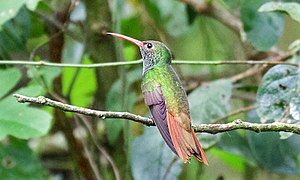Pale-bellied amazily
| Pale-bellied amazily | ||||||||||
|---|---|---|---|---|---|---|---|---|---|---|

Pale-bellied amazily |
||||||||||
| Systematics | ||||||||||
|
||||||||||
| Scientific name | ||||||||||
| Amazilia yucatanensis | ||||||||||
| ( Cabot , 1845) |
The Fahlbauchamazilie ( Amazilia yucatanensis ) or sometimes Yukatanamazilie called, is a species of bird from the family of hummingbirds (Trochilidae). The species has a large range that covers about 400,000 square kilometers in the North American country USA as well as the Central American countries Mexico , Guatemala and Belize . The IUCN assesses the population as Least Concern .
features
The pale-bellied amazilie reaches a body length of about 10 to 11 centimeters. The bright red beak has black spots and is about 1.33 times as big as the head. In the female, the upper part of the beak is black. Otherwise both sexes are very similar. They can weigh up to 3.8 grams. The throat and chest are shimmering green. The belly is light gray to yellow-brown in the subspecies chalconota , cinnamon brown in yucatanensis . The under tail-coverts are yellow-brown to cinnamon-colored and hardly stand out from the belly. The crown, the neck and the top shine golden green. The upper tail-coverts are dotted red-brown. The tail is red-brown. The inner control springs are green, the outer bronze-green.
Habitat
The hummingbird prefers to move in arid to semi-arid forest, scrubby bushes and forest clearings with flowers. But it can also be observed in city parks and gardens with appropriate vegetation .
behavior
The bird prefers to move in the thicket and on climbing plants. It also gets its nectar from the flowers in open gardens. In winter he leaves the area of the Rio Grande and moves south towards Mexico. Then he returns in spring.
Subspecies
So far, three subspecies are known.
- Amazilia yucatanensis yucatanensis ( Cabot , 1845)
- Amazilia yucatanensis chalconota Oberholser , 1898
- Amazilia yucatanensis cerviniventris ( Gould , 1856)
The subspecies yucatanensis occurs in southeastern Mexico, northern Belize and northwestern Guatemala. In Mexico they can be found in the states of Tabasco , Campeche and Yucatán . In eastern Mexico, in the states of Veracruz , Puebla and Chiapas , you can find the ssp. cerviniventris . Finally, chalconota is present in the south of the USA in Texas and in northeast Mexico to the south of the state of San Luis Potosí .
Etymology and history of research
Samuel Cabot described the pale-bellied amazily under the name Trochilus yucatanensis . The type specimen came from Yucatán . Only later was it added to the genus Amazilia .
The word Amazilia comes from a novella by Jean-François Marmontel , who reported on an Inca heroine named Amazili in Les Incas, Ou La Destruction De L'empire Du Pérou . The word »yucatanensis« refers to the collecting area Yucatán.
The word »chalconota« is a combination of the Greek words »khalkos χαλκός « for »bronze« and »nōton νῶτον « for »back«. The Latin word "cerviniventris" is of Latin origin and derives from "cervinus" for "deer-colored, deer-colored" and "venter" for "belly".
literature
- Ted Floyd: Smithsonian Field Guide to the Birds of North America , Collins, 2008, p. 262, ISBN 978-0061120404
- Mark W. Lockwood: Basic Texas Birds: A Field Guide , University of Texas Press, 2007, p.192ff, ISBN 978-0292713499
- Steve NG Howell, Sophie W. Webb: A Guide to the Birds of Mexico and Northern Central America . Oxford University Press, New York 1995, ISBN 978-0-19-854012-0 .
- Samuel Cabot: Dr. Cabot also exhibited, and read a description of, a new species of Humming-bird . In: Proceedings of the Boston Society of Natural History . tape 2 , 1845, p. 74-75 ( biodiversitylibrary.org ).
- Harry Church Oberholser: Description of a New Amazilia . In: The Auk . tape 15 , no. 1 , 1898, p. 32–36 ( sora.unm.edu [PDF; 204 kB ]).
- John Gould: On two new species of Humming Birds belonging to genus Amazilus . In: Proceedings of the Zoological Society of London . tape 24 , no. 310 , 1856, pp. 150-151 ( biodiversitylibrary.org ).
- James A. Jobling: Helm Dictionary of Scientific Bird Names . Christopher Helm, London 2010, ISBN 978-1-4081-2501-4 .
Web links
- Amazilia yucatanensis inthe IUCN 2013 Red List of Threatened Species . Listed by: BirdLife International, 2012. Retrieved January 30, 2014.
- BirdLife International: Species Factsheet - Buff-bellied Hummingbird ( Amazilia yucatanensis ) . Retrieved January 30, 2014.
- Videos, photos and sound recordings of Buff-bellied Hummingbird (Amazilia yucatanensis) in the Internet Bird Collection
- Pale-bellied amazilia ( Amazilia yucatanensis ) at Avibase; accessed on January 30, 2014.
- Amazilia yucatanensis in the Integrated Taxonomic Information System (ITIS). Retrieved January 30, 2014.
- xeno-canto: Sound recordings - Buff-bellied Hummingbird ( Amazilia yucatanensis )
- Pale-bellied Amazonia (Amazilia yucatanensis) in the Encyclopedia of Life . Accessed September 24, 2017.
Individual evidence
- ↑ Buff-bellied Hummingbird in eNature.com ( Memento of the original from January 7, 2010 in the Internet Archive ) Info: The archive link was automatically inserted and not yet checked. Please check the original and archive link according to the instructions and then remove this notice.
- ^ IOC World Bird List Hummingbirds
- ↑ a b Samuel Cabot, p. 74
- ↑ Harry Church Oberholser, p. 32
- ^ John Gould, p. 150
- ↑ on the publication date for zoonomes
- ↑ James A. Jobling p. 43
- ↑ James A. Jobling p. 412
- ↑ James A. Jobling p. 98
- ↑ James A. Jobling p. 97
